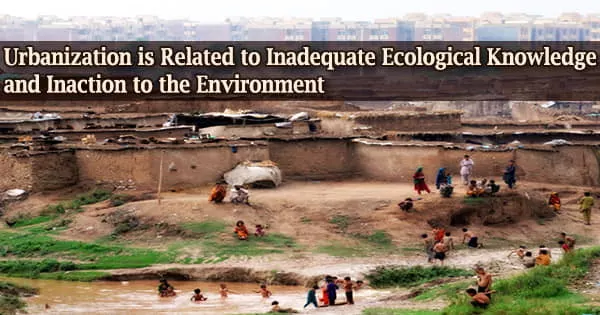In a recent study, National Institute of Standards and Technology (NIST) scientists and colleagues found significant differences between urban and suburban perspectives on coastal ecosystems.
The study’s authors used statistical and cognitive science methods to examine data from a survey of 1,400 people who lived along the East Coast of the United States. Their findings, which were reported in the journal npj Metropolitan Sustainability, revealed that respondents from urban areas frequently had a less complex and realistic understanding of coastal ecosystems than those from suburban locations.
The study also found that urban residents had a decreased willingness to act in favor of the environment. The study supports the existence of a problem known as urbanized knowledge syndrome, which may harm natural ecosystems and reduce a community’s ability to withstand natural disasters.
“We’re hypothesizing that urbanization is not only impacting the ecological dimension of the system, but also the social dimension of the system, which may, in turn, cause people to disengage from positive environmental behavior. It’s something of a snowball effect,” said Payam Aminpour, a NIST postdoctoral research fellow and lead author of the study.
Aminpour and his colleagues were particularly interested in learning more about the factors that influence decisions regarding resilience and adaptation strategies in urban settings as part of NIST’s Community Resilience Program. They were able to make a sizable step forward as a result of a survey created and circulated by study co-authors at Northeastern University.
The study’s target population consisted of coastal counties in metro areas in eight different states, each of which had a shoreline with differing densities of roads, sea walls, ditches, and other “gray” infrastructure. Residents of the six-level urban-rural classification system used by the National Center for Health Statistics were primarily found in the three most urban levels, which range from city centers to suburbs.
The questions were created to elicit data regarding respondents’ demographics, understanding of ecosystems, and participation in a list of pro-environmental activities, such as voting for political candidates based on their environmental stances, complaining to government organizations, making donations to conservation groups, and other actions.
Based on the survey results, Aminpour and colleagues at NIST developed fuzzy cognitive mapping techniques to create visual representations of each respondent’s ambient views.
We’re hypothesizing that urbanization is not only impacting the ecological dimension of the system, but also the social dimension of the system, which may, in turn, cause people to disengage from positive environmental behavior. It’s something of a snowball effect.
Payam Aminpour
The maps showed the kinds of correlations that were thought to exist between various environmental factors, such as how recreation areas affected wetlands and vice versa. Two separate sorts of maps developed as the study’s authors looked for patterns among the collection of maps.
Relationships tended to go in one direction on some respondents’ maps, displaying a mental model or manner of thinking known as linear thinking. Sea walls may be seen as free coastal defenses that stop erosion in a person’s linear cognitive process.
The belief that overfishing solely affects fish could serve as another illustration of linear thinking. Other inhabitants’ maps showed more intricate, reciprocal links, suggesting that they viewed the environment as a system.
This method of thinking, known as systems thinking, could help someone see that while sea walls give a shoreline structural strength, they also change how water flows down the shore, which may speed up erosion.
By reducing fish stocks, overfishing may result in future fishing regulations becoming more stringent, according to this line of thinking. The second of the two models is more likely to encourage individuals to think about complex parts of interactions between people and nature, notably the give-and-take dynamics between various components.
The team then looked for correlates and potential explanatory factors that might help explain why people choose either type of model.
“We explored the association of these two distinct clusters of mental models with many different aspects including education, age, political affiliation, homeownership,” Aminpour said. “We found that, among those factors, urbanization and the percentage of shorelines armored with gray infrastructure had strong positive associations with the mental models of residents that showed more linear thinking.”
In contrast, their investigation revealed that suburban residents, who live in an environment with fewer man-made buildings than urban residents, were more in line with systems thinking, according to Aminpour.
The self-reporting of behaviors that benefitted the environment indicated a significant behavioral difference between the two. The tendency toward linear thinking, which is typically exhibited by urbanites, was strongly associated with less pro-environmental action.
Aminpour explained that additional study required comparing every pair of maps inside the linear and systems thinking clusters in order to comprehend the variety of models in each.
The team found more evidence for urbanized knowledge syndrome, despite the fact that greater diversity of thought has historically been linked to greater flexibility and resilience in societies. While the group exhibiting systems thinking was far more diversified, the group exhibiting linear thinking and increased urbanization showed a high degree of uniformity.
Although there is a considerable correlation between environmental conditions and ways of thinking and acting in coastal communities, additional research is necessary before any firm conclusions can be made.
“We can’t yet say which comes first. Do you have systems thinking so you prefer to live in areas with more natural ecosystems, or does living in less urbanized areas make you develop systems thinking? We need more rigorous experiments to find out,” Aminpour said.
The researchers argue that it is crucial to find answers to these issues. Urban growth and gray infrastructure may be feeding a self-serving feedback cycle that could harm ecosystems and community resilience if urbanization does truly influence behavior.
Gaining access to more information and specific solutions can help make the case for more green infrastructure buildings and infrastructure that incorporates elements of nature. Additionally, it would contribute to NIST’s current study of the advantages that various types of infrastructure have for communities.
This strategy might reverse the loop, promoting increased systems thinking and sustainability.
“We have evidence that there’s something more going on with infrastructure. It may have a rippling effect through aspects of communities, like the diversity of thinking about the environment,” said Jennifer Helgeson, a NIST research economist and study co-author. “This is hopefully the tip of the iceberg of what we can learn.”
















